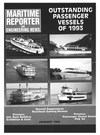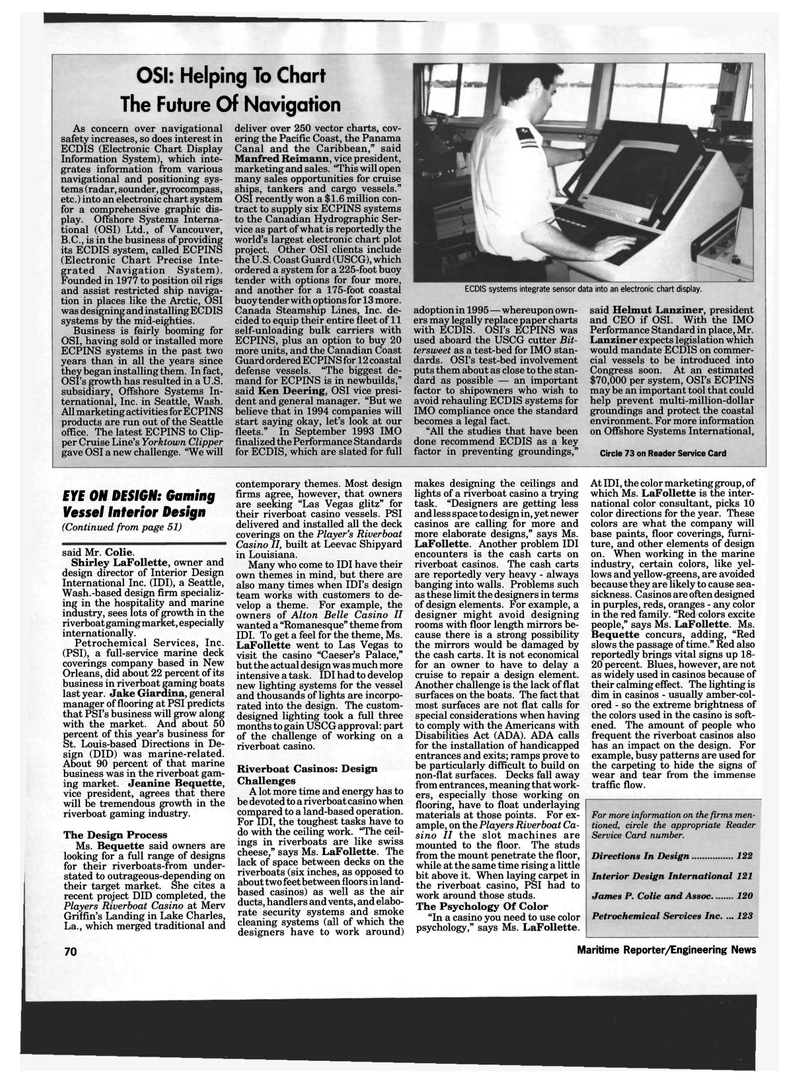
Page 68: of Maritime Reporter Magazine (January 1994)
Read this page in Pdf, Flash or Html5 edition of January 1994 Maritime Reporter Magazine
The Future Of Navigation
OSI: Helping To Chart
As concern over navigational safety increases, so does interest in
ECDIS (Electronic Chart Display
Information System), which inte- grates information from various navigational and positioning sys- tems (radar, sounder, gyrocompass, etc.) into an electronic chart system for a comprehensive graphic dis- play. Offshore Systems Interna- tional (OSI) Ltd., of Vancouver,
B.C., is in the business of providing its ECDIS system, called ECPINS (Electronic Chart Precise Inte- grated Navigation System).
Founded in 1977 to position oil rigs and assist restricted ship naviga- tion in places like the Arctic, OSI was designing and installing ECDIS systems by the mid-eighties.
Business is fairly booming for
OSI, having sold or installed more
ECPINS systems in the past two years than in all the years since they began installing them. In fact,
OSI's growth has resulted in a U.S. subsidiary, Offshore Systems In- ternational, Inc. in Seattle, Wash.
All marketing activities for ECPINS products are run out of the Seattle office. The latest ECPINS to Clip- per Cruise Line's Yorktown Clipper gave OSI a new challenge. "We will deliver over 250 vector charts, cov- ering the Pacific Coast, the Panama
Canal and the Caribbean," said
Manfred Reimann, vice president, marketing and sales. "This will open many sales opportunities for cruise ships, tankers and cargo vessels."
OSI recently won a $1.6 million con- tract to supply six ECPINS systems to the Canadian Hydrographic Ser- vice as part of what is reportedly the world's largest electronic chart plot project. Other OSI clients include the U.S. Coast Guard (USCG), which ordered a system for a 225-foot buoy tender with options for four more, and another for a 175-foot coastal buoy tender with options for 13 more.
Canada Steamship Lines, Inc. de- cided to equip their entire fleet of 11 self-unloading bulk carriers with
ECPINS, plus an option to buy 20 more units, and the Canadian Coast
Guard ordered ECPINS for 12 coastal defense vessels. "The biggest de- mand for ECPINS is in newbuilds," said Ken Deering, OSI vice presi- dent and general manager. "But we believe that in 1994 companies will start saying okay, let's look at our fleets." In September 1993 IMO finalized the Performance Standards for ECDIS, which are slated for full
ECDIS systems integrate sensor data into an electronic chart display. adoption in 1995—whereupon own- ers may legally replace paper charts with ECDIS. OSI's ECPINS was used aboard the USCG cutter Bit- tersweet as a test-bed for IMO stan- dards. OSI's test-bed involvement puts them about as close to the stan- dard as possible — an important factor to shipowners who wish to avoid rehauling ECDIS systems for
IMO compliance once the standard becomes a legal fact. "All the studies that have been done recommend ECDIS as a key factor in preventing groundings," said Helmut Lanziner, president and CEO if OSI. With the IMO
Performance Standard in place, Mr.
Lanziner expects legislation which would mandate ECDIS on commer- cial vessels to be introduced into
Congress soon. At an estimated $70,000 per system, OSI's ECPINS may be an important tool that could help prevent multi-million-dollar groundings and protect the coastal environment. For more information on Offshore Systems International,
Circle 73 on Reader Service Card
EYE ON DESIGN: Gaming
Vessel Interior Design (Continued from page 51) said Mr. Colie.
Shirley LaFollette, owner and design director of Interior Design
International Inc. (IDI), a Seattle,
Wash.-based design firm specializ- ing in the hospitality and marine industry, sees lots of growth in the riverboat gaming market, especially internationally.
Petrochemical Services, Inc. (PSI), a full-service marine deck coverings company based in New
Orleans, did about 22 percent of its business in riverboat gaming boats last year. Jake Giardina, general manager of flooring at PSI predicts that PSI's business will grow along with the market. And about 50 percent of this year's business for
St. Louis-based Directions in De- sign (DID) was marine-related.
About 90 percent of that marine business was in the riverboat gam- ing market. Jeanine Bequette, vice president, agrees that there will be tremendous growth in the riverboat gaming industry.
The Design Process
Ms. Bequette said owners are looking for a full range of designs for their riverboats-from under- stated to outrageous-depending on their target market. She cites a recent project DID completed, the
Players Riverboat Casino at Merv
Griffin's Landing in Lake Charles,
La., which merged traditional and 70 contemporary themes. Most design firms agree, however, that owners are seeking "Las Vegas glitz" for their riverboat casino vessels. PSI delivered and installed all the deck coverings on the Player's Riverboat
Casino II, built at Leevac Shipyard in Louisiana.
Many who come to IDI have their own themes in mind, but there are also many times when IDI's design team works with customers to de- velop a theme. For example, the owners of Alton Belle Casino II wanted a "Romanesque" theme from
IDI. To get a feel for the theme, Ms.
LaFollette went to Las Vegas to visit the casino "Caeser's Palace," but the actual design was much more intensive a task. IDI had to develop new lighting systems for the vessel and thousands of lights are incorpo- rated into the design. The custom- designed lighting took a full three months to gain USCG approval: part of the challenge of working on a riverboat casino.
Riverboat Casinos: Design
Challenges
A lot more time and energy has to be devoted to a riverboat casino when compared to a land-based operation.
For IDI, the toughest tasks have to do with the ceiling work. "The ceil- ings in riverboats are like swiss cheese," says Ms. LaFollette. The lack of space between decks on the riverboats (six inches, as opposed to about two feet between floors in land- based casinos) as well as the air ducts, handlers and vents, and elabo- rate security systems and smoke cleaning systems (all of which the designers have to work around) makes designing the ceilings and lights of a riverboat casino a trying task. "Designers are getting less and less space to design in, yet newer casinos are calling for more and more elaborate designs," says Ms.
LaFollette. Another problem IDI encounters is the cash carts on riverboat casinos. The cash carts are reportedly very heavy - always banging into walls. Problems such as these limit the designers in terms of design elements. For example, a designer might avoid designing rooms with floor length mirrors be- cause there is a strong possibility the mirrors would be damaged by the cash carts. It is not economical for an owner to have to delay a cruise to repair a design element.
Another challenge is the lack of flat surfaces on the boats. The fact that most surfaces are not flat calls for special considerations when having to comply with the Americans with
Disabilities Act (ADA). ADA calls for the installation of handicapped entrances and exits; ramps prove to be particularly difficult to build on non-flat surfaces. Decks fall away from entrances, meaning that work- ers, especially those working on flooring, have to float underlaying materials at those points. For ex- ample, on the Players Riverboat Ca- sino II the slot machines are mounted to the floor. The studs from the mount penetrate the floor, while at the same time rising a little bit above it. When laying carpet in the riverboat casino, PSI had to work around those studs.
The Psychology Of Color "In a casino you need to use color psychology," says Ms. LaFollette.
At IDI, the color marketing group, of which Ms. LaFollette is the inter- national color consultant, picks 10 color directions for the year. These colors are what the company will base paints, floor coverings, furni- ture, and other elements of design on. When working in the marine industry, certain colors, like yel- lows and yellow-greens, are avoided because they are likely to cause sea- sickness. Casinos are often designed in purples, reds, oranges - any color in the red family. "Red colors excite people," says Ms. LaFollette. Ms.
Bequette concurs, adding, "Red slows the passage of time." Red also reportedly brings vital signs up 18- 20 percent. Blues, however, are not as widely used in casinos because of their calming effect. The lighting is dim in casinos - usually amber-col- ored - so the extreme brightness of the colors used in the casino is soft- ened. The amount of people who frequent the riverboat casinos also has an impact on the design. For example, busy patterns are used for the carpeting to hide the signs of wear and tear from the immense traffic flow.
For more information on the firms men- tioned, circle the appropriate Reader
Service Card number.
Directions In Design 122
Interior Design International 121
James P. Colie and Assoc 120
Petrochemical Services Inc. ... 123
Maritime Reporter/Engineering News

 67
67

 69
69
